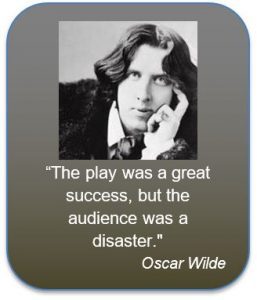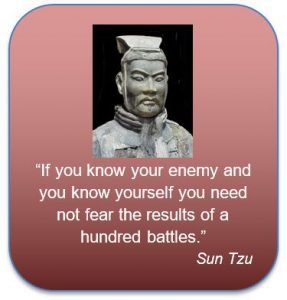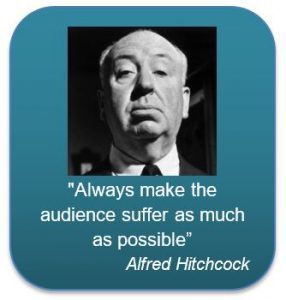The Question for Marketing. Do B2B sales teams use marketing content? It’s a legitimate question to ask as marketing leadership sets next year’s goals.
For many marketing teams, Account-Based Marketing (ABM) is at the top of their priority list. Marketing professionals, knowing they can’t close deals on their own, understand that Account-Based Selling (ABS) is necessary to execute effectively on ABM.
The Question for Sales. What do you want your sales teams to say when they are in front of the customer? It’s an urgent question to ask as sales leadership plans next year’s sales meetings.
Sales leaders know that the key to revenue growth is extending the practices of their best account executives to the 80% of sales reps in the middle of the pack. The best account executives know how to engage buyers in specific conversations that help buyers realize what your solution can do for them. Sales leaders need training, content and tools that spread those capabilities to the rest of the team.
Marketing and Sales – Bridge the Gap. B2B marketers need ABS to succeed with ABM. B2B sales teams need content and tools that engage customers in what your solution will deliver for them. Value Propositions satisfy both requirements. Value Propositions are the most important piece of content for B2B Account-Based Selling. Good Value Propositions provide the 3 key ingredients of ABM for differentiated solutions by being helpful, specific and relevant, but the best Value Propositions for ABS are also robust to the challenges of live sales interactions with sophisticated customers.
Great Value Propositions address account-specific business problems and opportunities of a buying organization as a whole. A strong Value Proposition supports customer conversations that are account-specific with respect to (i) an account’s identity and business, (ii) its problems and objectives and (iii) the decisions it is considering. Great Value Propositions also address the stakeholder-specific interests and concerns of individual within a buying team, enabling sales to speak the language that resonates with a stakeholder’s function, while helping to navigate the buying process through organizers, influencers and gatekeepers.
Value Propositions – ABS Tools for Better Sales Performance. Marketing, as they approach sales leaders with content to deploy in sales, needs to make a few simple persuasive points about why sales reps should listen. A recent analysis of over 1 million sales calls by Gong identified a number of key elements that separate the best sales performers (the top 20% by performance) from their peers. Let’s consider the Gong data as we look at 5 ways that Value Propositions, as ABS tools, improve sales performance:
- Value Propositions talk customer value not product features. The Gong data showed that the best reps spend 39% less time than average reps talking about technical topics and features. Star reps spend 52% more time talking about value-related subjects than average performers. The value topics they discussed were broad, including return on investment, the prospect’s pain points, the prospect’s business challenges, project agenda and timelines.
These results are not surprising. A Forrester survey of buyer executives found that the first vendor to communicate a vision of value wins the business three quarters of the time. An Aberdeen PJA survey asked buyer executives to select the two factors that play the greatest role in their decision to purchase a product or solution. Their top 3 answers were: (1) Total Cost of Ownership, (2) How the vendor’s solution supports the customer’s goals, and (3) ROI and efficiency gains. Buyers actively evaluate new solutions in their own business context, seek to understand value and do their own specific math.
buyer executives to select the two factors that play the greatest role in their decision to purchase a product or solution. Their top 3 answers were: (1) Total Cost of Ownership, (2) How the vendor’s solution supports the customer’s goals, and (3) ROI and efficiency gains. Buyers actively evaluate new solutions in their own business context, seek to understand value and do their own specific math.
Good Value Propositions provide content that relates to the needs and objectives of a sales team’s audience, going beyond product-focused content. Value Propositions are customer-centric, addressing what your solution does for your customer qualitatively. They are customer-specific, addressing what your solution does for your customer quantitatively and financially. At a general level, Value Propositions support a rational discussion of what you can deliver to your customer. At a targeted level, they help sales teams connect with specific customer problems and challenges, aligning sales teams with buyer stakeholders. Value Propositions create partnerships by focusing sales on a buyer’s specific, attainable success from implementing your solution. - Value Propositions support team selling. The Gong data show that the days of the lone-wolf sales rep are over. “Having just one sales call with multiple participants from your company makes you 258% more likely to close a deal than flying solo during the entire sales cycle.” Having multiple members of the sales team on a call delivers the relevant expertise to answer buyer questions and tells the buyer that they are important.
The positive impact of team selling in a world of complex solutions is consistent with changing commercial practice. A McKinsey team, writing in the Harvard Business Review, observed that in many B2B organizations, presales professionals represent 30-50% of commercial headcount. The McKinsey team highlighted the payoffs from augmenting presales efforts: (i) a five-point improvement in conversion rates, (ii) a 6–13% improvement in revenue, and (iii) a 10–20% improvement in the speed of moving prospects through the sales process.
Good Value Propositions bring sales teams together with a customer-centric focus. Sales teams, preparing to discuss a Flexible Case Study or a customer-specific Value Analysis, collaborate differently in their customer meeting preparation. Value Propositions focus the sales team on their understanding of the target’s business – the problems, needs and outcomes that matter specifically to this account and to stakeholders within the account. Your sales team naturally considers the customer’s business situation and business specifics when they prepare to present how your solution delivers business results and value to the account. - Value Propositions address the competition. It is unnatural for most sales teams to talk about the competition. The Richardson annual 2018 survey of sales executives identified their number one concern as “competing
 against a low cost provider.” Sales reps often wait with trepidation, hoping that the question of competition will never come up. When it does come up, they are frequently unprepared to address the competition directly.
against a low cost provider.” Sales reps often wait with trepidation, hoping that the question of competition will never come up. When it does come up, they are frequently unprepared to address the competition directly.
Yet the Gong data reveal that a deal is 49% likelier to close if you discuss the competition earlier in the sales process rather than later or never. Gong’s explanation is that you get the problem out of the way. “When you tackle the question of how you stack up against the competition early, you influence the prospect while they’re still forming opinions. By the time they get to yes, they’ll already have forgotten about the competition.”
Good Value Propositions emphasize the differentiation of your solution versus one or more competitors. They highlight your distinguishing features as well as your differentiating benefits and the financial value of your solution relative to at least one alternative. A comparator or competitor is implicit in any measurement of value, but it is rarely the same for all sales audiences. For some accounts and for some stakeholders, the relevant comparator is the status quo. For other accounts and stakeholders, the relevant comparator may be a direct competitor. A good Value Proposition provides direct comparisons with alternatives that build sales rep confidence that your solution is better and that its advantages justify your price points. That confidence helps sales teams address competition early and specifically in conversations with buyers. - Value Propositions invite sales to listen. The Gong data show that the best performing sales reps talk only 46% of the time and listen 54% percent of the time. This stands in stark contrast to average reps who talk 68% of the time, listening for only 32% and to low performing reps who talk 72% of the time while listening for 28%.
 Gong’s insights are common sense. “When prospects talk more, you learn valuable information and forge a connection. Listening more also keeps you from rambling or, even worse, talking yourself out of a deal.” If anything, team selling makes listening harder. Having additional people in a meeting makes it more difficult for all of them to pause simultaneously to see how buyer stakeholders will fill the silence.
Gong’s insights are common sense. “When prospects talk more, you learn valuable information and forge a connection. Listening more also keeps you from rambling or, even worse, talking yourself out of a deal.” If anything, team selling makes listening harder. Having additional people in a meeting makes it more difficult for all of them to pause simultaneously to see how buyer stakeholders will fill the silence.
Value Propositions invite customer engagement. Starting as a Flexible Case Study, a Value Proposition highlights the customer problems your solution solves, naturally inviting specific and relevant ABS questions: “Is sustainability an explicit corporate objective in this project? Who in your organization is responsible for energy efficiency? Do you know what you spend on electricity in the current facility?”
Value Propositions with specific information invite reactions as well, drawing buyers into case study discussions and helping to reshape them in a form specific to that account. The numbers don’t have to be perfect to get buyers engaged. Showing a few benchmark assumptions invites buyer reactions. “Our cost per kwh is $.01 lower than that. How did you estimate our reduction in material costs? Let’s put next year’s revenue targets in the assumptions.” By making Value Propositions specific to buyer objectives and business conditions, sales teams collaborate with buyer teams, building trust as they build consensus on a business case to buy. - Value Propositions support natural customer conversations. Listening to what customers say is important. Building an understanding of account and stakeholder problems helps to steer the sales process. But how sales reps draw customers into providing information and generating account insights matters as well. The Gong
 data show that average reps tend to concentrate their questions early in sales calls while the best reps ask questions throughout their calls. Taken together with the Gong data that average reps listen less than the best reps (#4 above), distinct differences in call patterns emerge. The best reps engage in conversations interactively and collaboratively, listening throughout their meetings. Average reps ask more questions and try to listen early in their calls before launching into one-way, non-interactive presentations that lose their buying audience. Average reps might have been trained to do discovery, but they often end up asking questions as if they are conducting an inquisition. The best reps understand how to weave good discovery into a collaborative conversation with their buyers.
data show that average reps tend to concentrate their questions early in sales calls while the best reps ask questions throughout their calls. Taken together with the Gong data that average reps listen less than the best reps (#4 above), distinct differences in call patterns emerge. The best reps engage in conversations interactively and collaboratively, listening throughout their meetings. Average reps ask more questions and try to listen early in their calls before launching into one-way, non-interactive presentations that lose their buying audience. Average reps might have been trained to do discovery, but they often end up asking questions as if they are conducting an inquisition. The best reps understand how to weave good discovery into a collaborative conversation with their buyers.
This is a critical point where a good Value Proposition is better than the average Value Calculator. They both seek to understand customer specifics, but the typical Value Calculator starts with too many blanks to fill in upfront. Good Value Propositions help sales teams tell a story about how you improved business outcomes starting with a case study. Good Value Propositions warm up a customer interaction gradually, providing ways for sales teams to discuss what you have done for others as they ask buyer stakeholders the occasional question about their specific problems and operating metrics. Discovery emerges from a discussion that credentializes the sales team rather than from a painful, fill-in-the-blank, checklist of questions. Good Value Propositions evolve from Flexible Case Studies early in the sales cycle to Customer Value Analyses during a customer evaluation to a Shared Business Case to Buy that helps sales teams speed the time to closing.
Value Propositions for Effective Sales Team Collaboration with Buying Teams. A substantial investment in ABM should go hand-in-hand with developing ABS content that delivers sales results. What does your marketing team expect that your sales team will say to specific customers? Your sales teams should compete with your competitors and partner with your key accounts, understanding your buyers’ business objectives through effective conversations. Partners need to deliver results that solve account-wide problems and need to build trust with individual buyer stakeholders. Helpful, specific, relevant and robust Value Propositions are the cornerstone of an effective ABS program.
The best B2B enterprises deploy Value Propositions to improve B2B sales performance, addressing sales challenges in a way consistent with an organization’s sales training, throughout the B2B sales cycle. It isn’t hard to start value selling or to generate value selling momentum. Value Propositions provide core sales content that helps sales teams engage in specific, relevant conversations about what your solution does for your customers and for its individual stakeholders. Value Propositions are a shared basis for collaboration that help sales teams win.
For more information on quantifying value for Value Propositions, see Can Your Sales Team Sell Your Solution’s Value? Can You?
For more information on designing Value Propositions see Designing Value Propositions for Sales Conversations
This is Part 4 of a 5-Part series. Part 1 of this blog series focused on Value Propositions as the most important piece of content for B2B Account-Based Selling. Part 2 highlighted the uses of great Value Propositions to address account-specific business problems and opportunities of a buying organization as a whole. Part 3 showed how Value Propositions can be used to engage individual stakeholders within an account. Part 5 will focus on the benefits of ABS for pricing strategy and execution.

